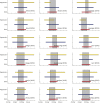Deep Neural Network-Based Concentration Model for Oak Pollen Allergy Warning in South Korea
- PMID: 31743971
- PMCID: PMC6875477
- DOI: 10.4168/aair.2020.12.1.149
Deep Neural Network-Based Concentration Model for Oak Pollen Allergy Warning in South Korea
Abstract
Purpose: Oak is the dominant tree species in Korea. Oak pollen has the highest sensitivity rate among all allergenic tree species in Korea. A deep neural network (DNN)-based estimation model was developed to determine the concentration of oak pollen and overcome the shortcomings of conventional regression models.
Methods: The DNN model proposed in this study utilized weather factors as the input and provided pollen concentrations as the output. Weather and pollen concentration data were used from 2007 to 2016 obtained from the Korea Meteorological Administration pollen observation network. Because it is difficult to prevent over-fitting and underestimation by using a DNN model alone, we developed a bootstrap aggregating-type ensemble model. Each of the 30 ensemble members was trained with random sampling at a fixed rate according to the pollen risk grade. To verify the effectiveness of the proposed model, we compared its performance with those of models of regression and support vector regression (SVR) under the same conditions, with respect to the prediction of pollen concentrations, risk levels, and season length.
Results: The mean absolute percentage error in the estimated pollen concentrations was 11.18%, 10.37%, and 5.04% for the regression, SVR and DNN models, respectively. The start of the pollen season was estimated to be 20, 22, and 6 days earlier than that predicted by the regression, SVR and DNN models, respectively. Similarly, the end of the pollen season was estimated to be 33, 20, and 9 days later that predicted by the regression, SVR and DNN models, respectively.
Conclusions: Overall, the DNN model performed better than the other models. However, the prediction of peak pollen concentrations needs improvement. Improved observation quality with optimization of the DNN model will resolve this issue.
Keywords: Pollen; allergic rhinitis; deep learning; pollen grains; quercus; seasons.
Copyright © 2020 The Korean Academy of Asthma, Allergy and Clinical Immunology · The Korean Academy of Pediatric Allergy and Respiratory Disease.
Conflict of interest statement
There are no financial or other issues that might lead to conflict of interest.
Figures



Similar articles
-
A biology-driven receptor model for daily pollen allergy risk in Korea based on Weibull probability density function.Int J Biometeorol. 2017 Feb;61(2):259-272. doi: 10.1007/s00484-016-1208-x. Epub 2016 Jul 7. Int J Biometeorol. 2017. PMID: 27387542
-
Spatial Assessment of Solar Radiation by Machine Learning and Deep Neural Network Models Using Data Provided by the COMS MI Geostationary Satellite: A Case Study in South Korea.Sensors (Basel). 2019 May 5;19(9):2082. doi: 10.3390/s19092082. Sensors (Basel). 2019. PMID: 31060305 Free PMC article.
-
Does the increase in ambient CO2 concentration elevate allergy risks posed by oak pollen?Int J Biometeorol. 2018 Sep;62(9):1587-1594. doi: 10.1007/s00484-018-1558-7. Epub 2018 May 10. Int J Biometeorol. 2018. PMID: 29748910
-
Deep learning ensemble with asymptotic techniques for oscillometric blood pressure estimation.Comput Methods Programs Biomed. 2017 Nov;151:1-13. doi: 10.1016/j.cmpb.2017.08.005. Epub 2017 Aug 8. Comput Methods Programs Biomed. 2017. PMID: 28946991
-
Oak pollen seasonality and severity across Europe and modelling the season start using a generalized phenological model.Sci Total Environ. 2019 May 1;663:527-536. doi: 10.1016/j.scitotenv.2019.01.212. Epub 2019 Jan 18. Sci Total Environ. 2019. PMID: 30716644
Cited by
-
Pollen Allergy in a Changing Planetary Environment.Allergy Asthma Immunol Res. 2022 Mar;14(2):168-181. doi: 10.4168/aair.2022.14.2.168. Allergy Asthma Immunol Res. 2022. PMID: 35255535 Free PMC article. Review.
-
Analysis of the Association Among Air Pollutants, Allergenic Pollen, and Respiratory Virus Infection of Children in Guri, Korea During Recent 5 Years.Allergy Asthma Immunol Res. 2022 May;14(3):289-299. doi: 10.4168/aair.2022.14.3.289. Allergy Asthma Immunol Res. 2022. PMID: 35557494 Free PMC article.
-
Prediction Model for Annual Variation in Total Pollen by Allergenic Trees in Korean Cities.Allergy Asthma Immunol Res. 2024 Jan;16(1):109-122. doi: 10.4168/aair.2024.16.1.109. Allergy Asthma Immunol Res. 2024. PMID: 38262394 Free PMC article.
References
-
- Hong SJ, Ahn KM, Lee SY, Kim KE. The prevalence of asthma and allergic diseases in Korean children. Korean J Pediatr. 2008;51:343–350.
-
- Jee HM, Kim KW, Kim CS, Sohn MH, Shin DC, Kim KE. Prevalence of asthma, rhinitis and eczema in Korean children using the International Study of Asthma and Allergies in Childhood (ISAAC) questionnaires. Pediatr Allergy Respir Dis. 2009;19:165–172.
-
- Kim KR, Kim M, Choe HS, Han MJ, Lee HR, Oh JW, et al. A biology-driven receptor model for daily pollen allergy risk in Korea based on Weibull probability density function. Int J Biometeorol. 2017;61:259–272. - PubMed

